Authors:
Jen Liu, Monique Verdin, Ozone504
As human-induced climate crises unfold on a planetary scale, climate-related disasters are becoming more intense and frequent. These events pose critical challenges and vital opportunities for ways in which researchers and practitioners need to approach computing systems in an era shaped by ecological disruption. Floods, storms, and wildfires, for example, can hinder computing technologies by damaging infrastructure and bringing networks offline. At the same time, these technologies can be used to support crucial disaster relief efforts, providing information and communication in moments of emergency. Fields such as crisis informatics and computer-supported cooperative work have long offered valuable lenses for understanding how technology mediates disaster response, coordination, and resilience. Yet, as the climate crisis deepens, there is a growing need to move beyond a focus on short-term disruptions and toward an engagement with the slow, uneven, systemic, and intersecting nature of climate-related disasters. How can we design technologies that proactively support resilience, equity, and care in an ongoing climate emergency?
→ Climate action must be rooted in community knowledge and practices.
→ The legacy of mutual aid is an important way that communities have organized.
→ Interactive systems should be designed to account for the instability of underlying infrastructures, such as electricity and communication.
In this article, we reflect on this question by focusing on the Mississippi River in southeast Louisiana. We are witnessing the accelerated impacts of climate change—from coastal erosion and land loss to sea level rise and floods. Most notably, we are seeing more intense hurricanes, fueled by warming ocean temperatures. Southeast Louisiana is also home to deep-rooted traditions of mutual aid and community-led support systems forged in response to disaster and neglect. In the sections that follow, we examine post-hurricane communication and recovery in the region and our work designing SwampNet, an ongoing process to build alternative networks in collaboration with mutual aid communities in New Orleans.
 Disasters and Mutual Aid in Southeast Louisiana
Disasters and Mutual Aid in Southeast Louisiana
Hurricane Katrina made landfall on August 29, 2005, causing catastrophic destruction. The storm revealed the vulnerability of communication infrastructures. Utility poles were toppled and base stations flooded, leaving 3 million people without power. The breakdown in communication delayed emergency response by government agencies, and many, particularly those who were elderly, Black, and poor, were left without help.
In the absence of official aid, grassroots efforts emerged. One initiative was the Common Ground Collective, which consisted of local organizers and out-of-state volunteers who provided direct relief distributing food and medicine. Members of Common Ground created a media hub in the Algiers Point neighborhood. Using a temporary license from the Federal Communications Commission, they set up a low-power FM radio station and provided a space for journalists and media activists to locally broadcast news and updates [1].
This type of work is tied to a long history of mutual aid organizing in the region. Historically, Black communities formed mutual aid groups in the form of social aid and pleasure clubs and benevolent societies as early as the 1780s. These organizations served their community members who had been excluded from banks and other institutions due to systemic racism [2]. The groups offered funeral services, financial support, and gathering spaces at the height of segregation. By the mid 20th century, groups such as the New Orleans chapter of the Black Panther Party were engaged in mutual aid work, addressing their community's needs, including organizing a national breakfast program for schoolchildren, health screenings, and political education classes. Malik Rahim, a former Panther member, would later cofound the Common Ground Collective.
One unexpected outcome in the aftermath of Katrina was the use of cell phones to communicate and coordinate disaster relief. In the early 2000s, cell phones had become more widespread as a form of technology that people could access at all times. Unlike landline phones and desktop computers, which required a physical tethering to wall jacks and outlets, the cell phone was a portable communication device. When people were evacuating New Orleans, texting became the communication option of last resort as landlines flooded [3]. Afterward, people became more accustomed to incorporating text messaging in their everyday communication practices, including within mutual aid groups.
Following Katrina, communications infrastructures received federal and state investment, but it was not enough. On August 29, 2021, 16 years after Katrina made landfall, Hurricane Ida, a Category 4 storm, swept through southeast Louisiana, with winds of 150 miles per hour recorded. In the aftermath, millions of people were left without power. Mutual aid groups that had mobilized for the Covid-19 pandemic expanded to provide hurricane relief, creating hubs to distribute food, water, and clothing, with areas for people to cool off, rest, and charge their phones.
In the months following Ida, Bvlbancha Liberation Radio, an Indigenous-led microgrid communication center, began hosting meetings for mutual aid groups to connect and strategize ahead of the next disaster. As many community members noted, the lack of communications hampered their own relief efforts. Downed cell towers led to dropped calls and delayed text messages, while digital documents were inaccessible. Through these meetings, a question emerged: How can communication networks be built to support existing mutual aid networks?
In the spring of 2023, we began building an emergency network to support mutual aid communications. Our goal was to be ready in time for the peak hurricane season in mid-August. A central concern that emerged was how to coordinate with other hubs when Internet and cell infrastructures fail. Without communication, people would have to travel from one location to another, a task that often can be even more difficult in post-storm conditions as roads may be blocked or impassable and gas in short supply.
Designers and researchers must reimagine interactive systems as tools for collective survival, built with and for people navigating ongoing disruptions.
Based on these discussions, we decided on a mesh network model to connect different hubs, with each one hosting a node. Given the limited time frame, budget, and computer networking experience in the mutual aid community, we opted for preexisting software and off-the-shelf components to build our network. We used Meshtastic, an open-source software for off-grid and decentralized networks that uses LoRa (from long-range), a radio technique that can send signals over long distances using low-powered devices, such as microcontrollers. The microcontrollers can then connect via Bluetooth to phones and tablets, allowing peer-to-peer messaging across the network.
At the next mutual aid meeting, we shared our ongoing work, including an overview of mesh networks and a demonstration of a simple message exchange across two smartphones. Meeting participants took turns sending messages from one device to another and brainstormed how they would use the tool in a post-disaster context. One key concern was highlighted: trusting that the network would work in different conditions, given the uncertainties following storms. This insight informed our next step—testing the network. Following our demo, several hubs volunteered to be nodes.
Testing the network. We conducted a series of range tests to see how far we could send and receive a signal from a node (Figure 1). The location at which the signal drops off is where another node can be added to relay the message across the network. Meshtastic was reported as being able to send messages over 100 miles (approximately 161 kilometers), but these results were obtained in mountainous regions where there was little interference. The dense urban environment of New Orleans required closer node placements and finding ways to navigate other physical barriers.
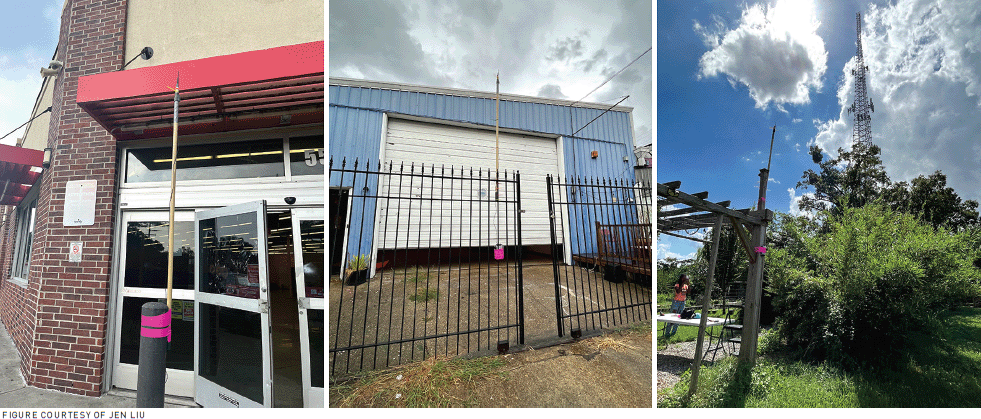 | Figure 1. Antennae installed at various mutual aid hubs for range tests. |
These range tests also doubled as training during which volunteers learned how to set up a node, use the networking equipment, and establish basic troubleshooting protocols. Range testing was a coordinated effort, where volunteers were assigned a series of mapped locations to test signals at intervals of 0.5 miles (0.8 kilometers). From these range tests, we saw how our signals were affected by unexpected tree coverage and urban infrastructures, such as bridges, buildings, and other radio networks. These insights allowed us to adjust our network to establish a clearer line of sight between nodes.
In addition to range testing, we built kits containing the microcontroller, antennae, battery, and instructions needed to set up the mesh network (Figure 2). Based on feedback from mutual aid community members on how to make the nodes more self-sufficient, we added a way for the kit to be solar powered by adapting a solar panel, charge controller, and battery from security lights. We held workshops for mutual aid members to assemble the kits, which included teaching participants how to solder and disassemble electronics (Figure 3). While many mutual aid members had no prior experience building communication networks, they were familiar with learning new skills to support their work. They had to learn how to calculate electricity loads so they could understand the capacity of temporary energy sources, how to create air filtration devices to prevent the spread of Covid-19 and other airborne illnesses, and how to treat dehydration and other first-aid practices that are common after storms. While many mutual aid community members did not foresee learning to build and operate a mesh network, they recognized the importance in creating these networks to ensure that their communities would stay safe in post-disaster relief scenarios.
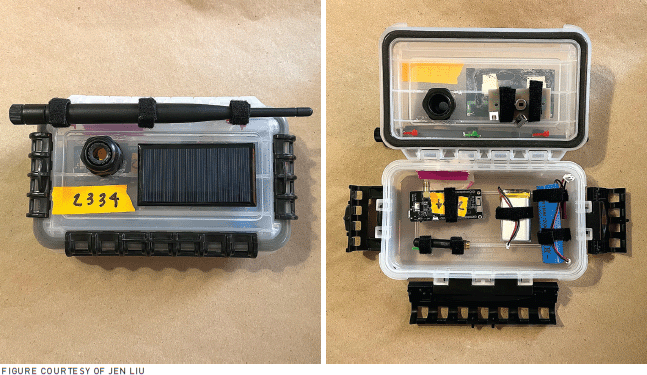 | Figure 2. Mesh kits with hacked solar panels. |
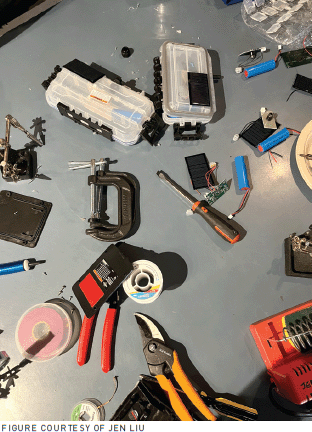 | Figure 3. Equipment used in a soldering and kit assembly workshop. |
One member described how they unexpectedly had to learn how to build and maintain solar generators and panels. In recent years, many groups have sought solar power as an alternative to diesel generators because of the scarce fuel supply following hurricanes and due to concerns around carbon monoxide poisoning. This pivot to other sources of energy is also an important departure from the region's historical reliance on the fossil fuels industry. The oil and gas industry plays a significant role in the economy of Louisiana, but often at the detriment of the state's most vulnerable and marginalized residents. For example, petrochemical facilities are often built near rural Black communities, while Indigenous communities near the coast are losing their land due to subsidence and erosion from industrial canals created to transport equipment and supplies. Furthermore, the carbon emissions from fossil fuels contribute significantly to the warming of ocean waters, creating devastating storms such as Hurricane Ida and others that increasingly strike this region. Gaining these skills is important for members of mutual aid groups to reimagine what post-disaster relief could look like in their communities and how they envision the future, especially in a region already facing the accelerated impacts of climate change.
Awaiting the storm. By the peak of hurricane season in 2023, our network was deployed across six nodes, connecting distribution hubs in four neighborhoods. And then we waited. We watched the forecasts as hurricanes formed in the Gulf and struck other communities along the coast, breathing a sigh of relief when hurricane season ended in November. Before the hurricane season in 2024, we tested the equipment in every kit, updated software, and ran training workshops for community members. In between, we did outreach at public events, inviting more community members to learn about our project. For the most part, the hurricane season was quiet in southeast Louisiana. In many ways, we are relieved that our network has yet to be fully utilized as it means that a powerful enough storm has not caused widespread damage. Yet, as we know from experience, it is a question of when, not if, the next storm will hit.
This August marks 20 years since Hurricane Katrina and four years since Hurricane Ida. Our communication practices to support one another in moments of emergency have evolved with the use of cell phones and other devices, yet the underlying communication infrastructures are still fragile and vulnerable. A lot of work still needs to be done to ensure that communities have what they need to recover after climate-related disasters and be oriented toward longer-term solutions. In preparation for this year's hurricane season, we are again performing routine maintenance on kits while recruiting additional hubs to join our growing network. Working with Community Tech New York and other groups, we have started experimenting with other networking technologies, including servers that can function as standalone information repositories. We are connecting with communities in the rural prairies and bayous of south Louisiana to think about what communication technologies could look like in other ecologies as they navigate the impacts of climate change.
As climate disasters intensify, designers and researchers must reimagine interactive systems as tools for collective survival, built with and for people navigating ongoing disruptions [4]. For us, SwampNet is a form of prefigurative design that reminds us that building just and livable futures will depend not just on innovative ways of working with technologies but also on the strength of communities to learn, adapt, and act as a network [5]. Our work underscores the importance of these technologies to go beyond emergency tools, creating essential infrastructures that sustain care, solidarity, and survival in a rapidly changing world.
1. Crow, S. Black Flags and Windmills: Hope, Anarchy, and the Common Ground Collective. PM Press, 2011.
2. Belblidia, M. and Kliebert, C. Mutual aid: A grassroots model for justice and equity in emergency management. In Justice, Equity, and Emergency Management. A. Jerolleman and W.L. Waugh Jr., eds. Emerald Publishing Limited, 2022.
3. Garnett, J.L. and Kouzmin, A. Communicating throughout Katrina: Competing and complementary conceptual lenses on crisis communication. Public Administration Review 67, 1 (2007), 171–188.
4. Jang, E .H.B. et al. Situating network infrastructure with people, practices, and beyond: A community building workshop. Companion Publication of the 2022 Conference on Computer Supported Cooperative Work and Social Computing. ACM, 2022, 267–272.
5. Asad, M. Prefigurative design as a method for research justice. Proc. of the ACM on Human-Computer Interaction 3, CSCW (2019), Article 200, 1–18.
Jen Liu is a Ph.D. student in the Information Science department at Cornell University. Her work studies the ecological, social, and political implications of computing technologies and infrastructures. She employs ethnographic and design methods to understand these challenges and build alternatives for livable and equitable futures. [email protected]
Monique Verdin is an artist, citizen of the Houma Nation, and steward of the Land Memory Bank and Seed Exchange. She co-stewards Bvlbancha Liberation Radio and the earthen mound Nanih Bvlbancha, and is experimenting with autonomous and alternative communication systems with the mutual aid SwampNet project. [email protected]
Ozone504 is a social practice artist living in Bvlbancha. He is a former arts editor of Bulbanchia Is Still a Place and is currently an engineer for Bvlbancha Liberation Radio and caretaker for Nanih Bvlbancha. He uses a pseudonym to publicly represent himself in the context of his creative work. [email protected]
 This work is licensed under Creative Commons Attribution International 4.0.
This work is licensed under Creative Commons Attribution International 4.0.
The Digital Library is published by the Association for Computing Machinery. Copyright © 2025 ACM, Inc.
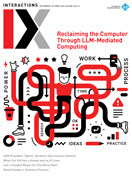

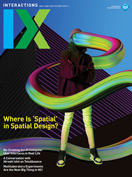



Post Comment
No Comments Found